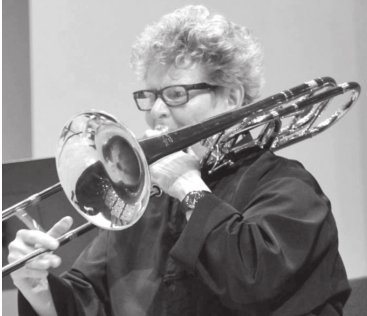
The words “introspection” and “trombone concerto” are seldom heard together.
Let’s work on that.
Symphonic fireworks and cataclysms are great, but Thursday’s Lansing Symphony concert featured something very different — a profound meditation on life’s mysteries, issuing in low tones from a long metal tube.
The setup for MSU composition professor David Biedenbender’s new trombone concerto, written for Lansing Symphony principal trombone Ava Ordman, was a bit of a fakeout.
In a brief talk from the stage, Biedenbender said the music was inspired by the way his children see the world, reacting spontaneously to life and giving their imagination free rein. That was a red flag. Would this be another round of the Disney-ish, sugary post-modernism that often passes for new music at symphony concerts these days?
Uh-uh. As it turns out, childlike innocence and honesty is serious stuff.
It began with prickly tingles of percussion, upwelling Wagner-isms from the horns and low brass and aurora-like sheets of sound from the strings that were not standard issue. Child’s play or not, this music had a dark, vertiginous undertow.
As the inchoate canvas came together, the stage was set for a series of ever-bigger bangs, but that’s not where the music went.
Ordman asserted her presence in almost tentative tones, as the orchestra vaguely ticktocked the inexorable passage of time.
Suddenly, the orchestra stopped playing, leaving her to plumb her isolation with a heartbreaking mix of dignity and vulnerability. It felt like a violation of her privacy to overhear what sounded like long-hidden thoughts.
This was deeply personal music, very different from the flashy back-and-forth volleys that fill most violin or piano concertos. The pure, coppery tones curling out of Ordman’s instrument went up your back, into your neck and straight up the base of your brain.
The orchestra cautiously edged back into the picture, trying a few different voices. The music was constantly on the verge of resolving into a juicy melody or sweet series of chords — i.e., an easy answer — but it never did.
The layers of harmony dissipated, leaving a skeletal dance of percussion. Then even that vanished. Ordman was alone again. This time, though, her phrases were chopped into agitated gasps, as if she had gotten too starry-eyed while taking a spacewalk and gotten into trouble.
Just when she seemed at the end of her tether, running out of oxygen and close to panic, principal flutist Richard Sherman threw her a tuneful lifeline. She picked up the reassuring melody. The orchestra followed her lead and came back to life.
It’s no wonder the seemingly archaic concerto form has lasted so long. It has evolved from a way to show off one musician’s virtuosity against a fancy backdrop to something much deeper – a perfect platform for playing out the relationship between a soul and the universe around it.
The scary isolation was over, but then came the absorption. Crazy up and down scales started to swirl around Ordman, coming from all directions, with even a flexatone wobbling around to ramp up the chaos.
Suddenly, a goosebump-raising brass chord activated at full force, turning the music’s existential alleys into a neon-drenched Times Square. The icy incandescence revealed a place full of monsters — every section of the orchestra was suddenly huge, active and in your face. Ordman’s only resort at this point was to channel her inner child and ride it all out. That’s how to deal with life, and maybe even with death. She dropped all signs of resistance and surfed the wave until it broke.
Playing a new piece, with a hometown hero like Ordman in the spotlight, seemed to energize and engage the musicians at the highest level. The musicians were on the edge of their seats, firing cross-glances at each other and maestro Timothy Muffitt.
The concerto itself is a fabulous mystery that deserves to be heard again — and it will, as it makes the rounds of a consortium of trombone players who commissioned it, with Ordman in the lead.
The same mood of introspection saturated the other two pieces the symphony played Thursday night — even Beethoven’s blustery “Egmont” overture. Muffitt is never one to rush to a dramatic conclusion when there’s a journey to be savored.
The biggest work of the night, Brahms’ Third Symphony, is a sublime series of idylls, reflections and meditations that’s almost devoid of artificially whipped-up drama. The danger here is to let the music slacken into solipsism and, subsequently, sleep, but Muffitt and the LSO delivered an intimate, chamber-music performance that swelled to grand proportions when called for and receded again with a natural, cosmic breath.
Support City Pulse - Donate Today!
Comments
No comments on this item Please log in to comment by clicking here